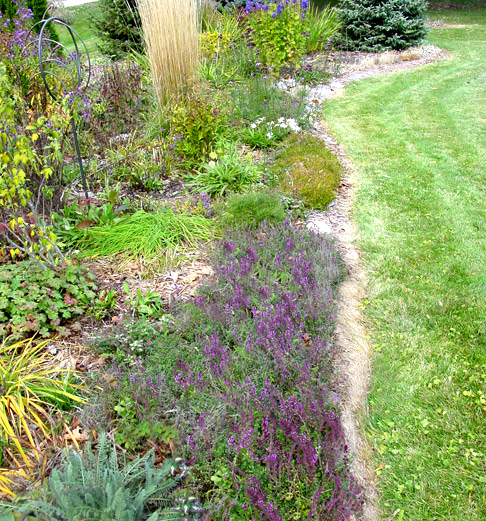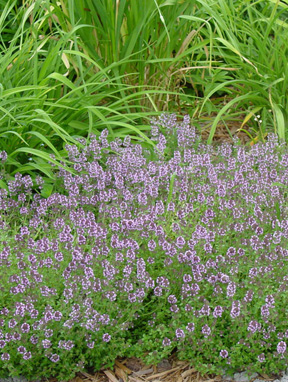About five years ago I decided to try growing herbs. I planted chives, basil, lemon thyme, oregano, sage and rosemary on one end of the raised vegetable garden. For the most part they did pretty well and I found that I loved cooking with fresh herbs. One of my favorite things was trying different combinations of the herbs in familiar recipes and I picked herbs pretty much every day that summer. When winter came, I expected all the herbs to die from the cold except for chives which I knew were perennial.
When spring arrived, I noticed that the chives, oregano and lemon thyme (Thymus citriodorus) had wintered through nicely and were sending out new shoots. That second year all of those herbs grew much bigger and actually bloomed, which was a nice surprise. I was especially taken with the flowers on the lemon thyme. They were a lovely lavender/purple color and since the thyme had a low spreading growth habit, I decided to move a small clump to the front of a sunny flower bed in our yard.
It was an immediate success. I kept taking bits of the newly rooted sections from along the edges of my thyme clump and moving those small sections to other front border areas. I loved the way it sprawled in front of the taller plants, creating a block of color from the fragrant blooms that began in July and lasted until frost. I also found that these plants grew best in full sun and while they did survive in part shade, I didn’t get nearly as many flowers. In the last few years I have given away small starter plants from my thyme borders to a few friends and have seen them grow under different conditions. Lemon thyme seems to love sun and even dry sandy soil, but struggles and will die in shade areas.
Our yard has mostly clay soil that I have been amending for years. I know heavy soil is not the optimal condition for growing thyme, but I have enjoyed great success with this plant. I use it both in the front border for color and as an herb for cooking. Since I purchased my original lemon thyme plant in a small herb pot one spring for about a dollar, I consider it one of my best success stories!
Research
In researching this plant I found that thyme is a member of the mint family that thrives in sandy well-drained soil in full sun. Out of more than 400 varieties of thyme that exist in nature, dozens are available through nurseries. Lemon Thyme (Thymus citriodorus), the variety that I chose, smells like lemon and tastes like lemon. It can be used in any recipe calling for lemon juice, lemon zest or lemon flavoring. Lemon Thyme added to marinade is great with fish or chicken and I have been using it in a lot of different recipes.






I will have to plant thyme again. I haven’t had any of it for a couple of years. You make a good case for the lemon thyme. I do use a lot thyme in cooking.
Craig and I were given a bunch of vegetable plants from his mother this year, tomatoes, peppers, cabbage, and a couple of them we thought were peppers until they started getting bigger we later found out they were lemon sage, oh they smelled sooo good, but I wasn’t sure if I could cook with that so everytime we were out in our garden we would run our fingers up the blossoms and smell the lemony sent and the boy’s and I would go “ahhhhhhh”…I may have to try the herb thing next year!
I’m going to give it a try in my garden next spring. Thanks for the idea!